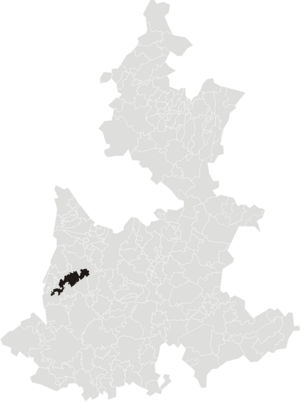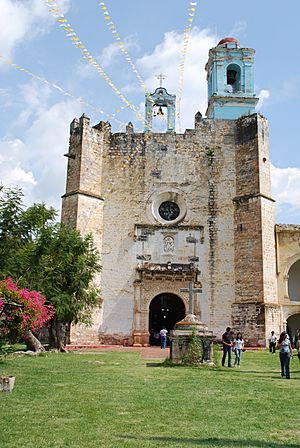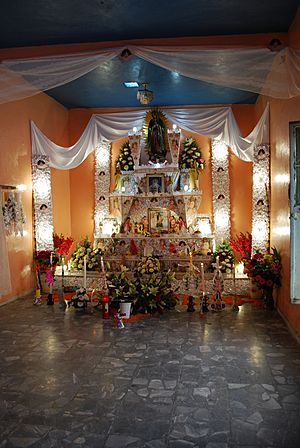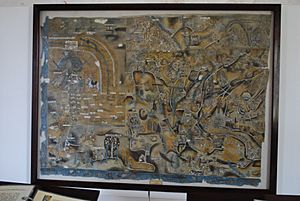Huaquechula facts for kids
Quick facts for kids
Huaquechila
|
||
|---|---|---|
|
City
|
||
| Huaquechula | ||

Location of municipality
|
||
|
||
| Country | ||
| State | Puebla | |
| Founded | 1110 (official) | |
| Municipal Status | 1895 | |
| Population
(2005)Municipality
|
||
| • Municipality | 26,114 | |
| Time zone | UTC−6 (Central (US Central)) | |
| • Summer (DST) | UTC−5 (Central) | |
| Website | www.huaquechula.gob.mx | |
Huaquechula is a town in the state of Puebla, located in central Mexico. This town has a very long history, going back to at least 1110 CE. Its main center has moved twice to where it is today.
For centuries, Huaquechula has been a farming community. People here grow crops like peanuts, corn, and sorghum. The town is also known for its special traditions, especially those linked to the Feast of the Cross. Even more famous are its "cabo del año" altars, which are created for Day of the Dead. These altars honor family members who have passed away in the past year. They are so unique that they have been recognized as a cultural heritage of Puebla state. Many tourists, especially from Puebla, visit the town to see them.
Contents
Exploring Huaquechula Town
The town of Huaquechula is about 60 kilometers (37 miles) from Puebla, the state capital. It is built around a main plaza, which is like a central square. In this plaza, you can find old stone pieces that tell about the area's past. These include a calendar stone, parts of a stone head of Quetzalcoatl (an ancient god), and a tombstone with a date written in the Aztec calendar. The plaza also has a fountain made of black sandstone.
Around the main plaza, you will see important buildings. These include the town hall, a church, a cultural center called Cuauhquechollan, and a very old monastery from the 16th century.
The Historic Monastery
The monastery was started in 1531 and finished in 1580. It was built by the Franciscan order, a group of monks. It looks similar to another famous monastery in Huejotzingo. The front of the monastery is decorated in a style called Plateresque, which means it has very detailed and fancy stone carvings, especially around the main entrance. The open chapel, which is a special outdoor area for services, is built in a Gothic style.
Inside the monastery, the main altarpiece (a decorated screen behind the altar) is also Plateresque. It dates back to the 17th century and is very large, over ten meters (33 feet) tall and five meters (16 feet) wide. The old living area for the monks, called the cloister, is now a local museum. On the walls, you can still see parts of the monastery's beautiful old paintings. The museum rooms display ancient artifacts, copies of various Aztec codices (ancient books), and a special section about Day of the Dead traditions. In front of the monastery, there is a stone cross placed over an image of the world, with pictures of the sun and moon.
Ancient Stone Monuments
Huaquechula also has other reminders of its long history. The Piedra Máscara, or "Stone Mask," is a monument on an old road. It shows the old gods of the people who lived here before the Spanish arrived. The Piedra del Sol y la Luna, or "Stone of the Sun and Moon," is on another old road and shows a lunar eclipse. The Piedra del Coyote, or "Coyote Stone," is near a river. It tells a story about the death of a coyote. Later, a cross was placed on top of this stone.
The town's patron saint is Saint Francis of Assisi, and his feast day is celebrated on October 4.
Life and Work in Huaquechula
For many centuries, the main way people make a living in Huaquechula has been through farming. They grow crops like peanuts, corn, onions, and sorghum. People also raise livestock and run small businesses.
The town is also known for its traditional handcrafts. These include beautiful items made from wax, tin, and pressed glass. You can find jars, candelabras (candle holders), and incense burners. These often have designs of angels, the Virgin Mary, and flowers.
Unique Traditions: Day of the Dead Altars and the Holy Cross Festival
Huaquechula is famous for two yearly events with traditions found nowhere else. The most well-known are the "cabo del año" (end of the year) altars. These are made for family members who have passed away in the last year.
Day of the Dead Altars
Like the rest of Mexico, people in Huaquechula celebrate Day of the Dead with traditional "ofrendas" or altars for all loved ones. However, those who died recently get their own special altar on the first Day of the Dead after their passing. These altars are usually very large and shaped like a pyramid. They are covered in white satin or crepe paper, folded to look like clouds. The upper levels are held up by special columns, often in a fancy style called Baroque estipite. These altars mix old traditions from before the Spanish arrived with altars originally made for Maundy Thursday. This is why they are mostly white. Each altar is built new for the recently deceased and can be quite expensive to create, depending on its size and how much it is decorated.
Most "cabo del año" altars have three levels.
- The lowest level represents life on Earth for the person who passed away. A photo of the person is placed in the center. Traditionally, you can only see the photo indirectly using a mirror. People have different ideas why this is done. Some say the mirror shows the entrance to the afterlife, or it represents forever, or it means the person is no longer here. Around the photo, there are offerings of things the person enjoyed in life. These often include foods like plates of mole, tamales, sweets, fruit, hot chocolate, atole, tequila, mezcal, and beer. There are also special breads baked for these altars in Huaquechula. "Hojaldra" bread represents the skull and bones, "rosquete" bread represents the face, and "pan de muerto" (bread of the dead) represents the human body. Wax candles are placed to give light, and there are twelve images of angels, one for each month. Incense and images of crying angels represent the grieving family. If the person who died was a child, there might also be small sugar animals like sheep, ducks, and donkeys.
- The second level is about the connection between people and the Divine (God), and also represents heaven. Here, you can find images of angels, the Virgin Mary, and the Host (a religious symbol). There are also religious items and candles of different sizes. Today, many altars use electric lights instead of or in addition to candles. Decorations include sugar skulls, incense burners, and marigold flowers.
- The third level is dedicated to the Divine. It often features a cross or an image of the Trinity (Father, Son, and Holy Spirit).
These altars are usually set up in a front room or hallway, close to the main entrance of the house. Most often, they are open for the public to view on November 1 and 2. It is a custom for these families to offer food and drinks to visitors. This includes traditional foods like hot chocolate, atole, mole, tamales, and bread. Most visitors come from the state of Puebla, but people from other parts of Mexico and even other countries are starting to visit. Even though families with these altars are sad, most are also proud to share this special custom and talk about the life of the person they are remembering. These altars were officially recognized as part of Puebla's Cultural Heritage in 1977.
The Feast of the Holy Cross
Another important festival is the Feast of the Holy Cross, which has been celebrated for a very long time, since the colonial period. The town has a special cross made from basalt stone called the "Cruz de Huaquechula." It is said to contain pieces related to the original cross of Christ. People say it is so heavy that it can only be lifted if the people carrying it pray, and the church plays a special song on its bells.
The festival lasts for nine days, starting in April and ending on May 3. It includes church services, traditional dances, food, and music played by bands with wind instruments. There are also fireworks set off from large frames shaped like bulls. This event has also been named part of Puebla's Cultural Heritage. During this festival, you can see traditional festive clothing like that of the charro (Mexican cowboy) and the China Poblana (a traditional Mexican dress).
Huaquechula's History
The name Huaquechula comes from the Nahuatl language, cuauhquechollan. It means "place of eagles and roseate spoonbills," which are types of birds.
The town was first settled around 1110 CE by groups called Xicalancas and Teochichimecas. This first settlement was just north of where the town is now. In 1200, the town was re-established by the Nahuas, a bit south of the modern town. The current town layout was set up by the Spanish in 1520.
In the early 16th century, this area was the site of a battle between the Tlaxcaltecas and the Mexicas. The Tlaxcaltecas caused a lot of damage. A son of Moctezuma Xocoyotzin (also known as Moctezuma II), who was the ruler of the Mexicas, died in this battle.
The Huaquechula area was an important route for supplies and soldiers during the Spanish conquest of Tenochtitlan (the Aztec capital). After the conquest, the area came under the control of Jorge de Alvarado in 1524. In the 17th century, it became directly controlled by the Spanish Crown as part of the Atlixco district. Finally, in 1895, Huaquechula became an independent municipality, which means it could govern itself.
See also
 In Spanish: Huaquechula para niños
In Spanish: Huaquechula para niños







